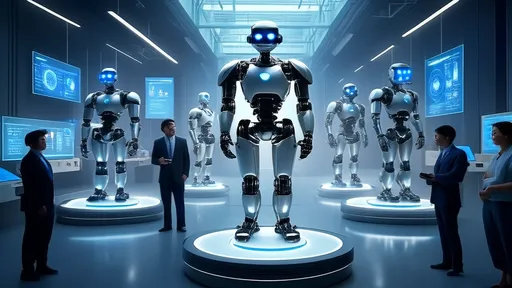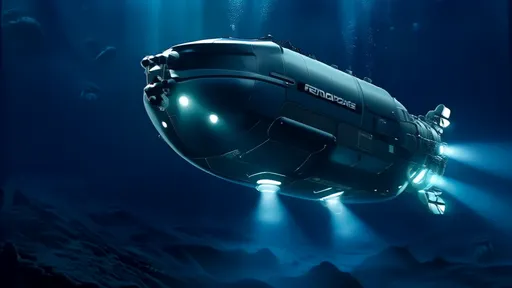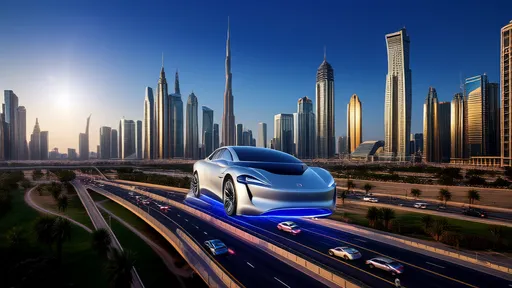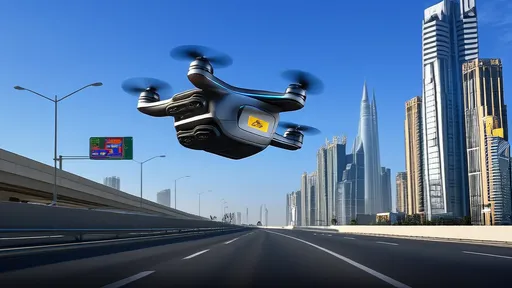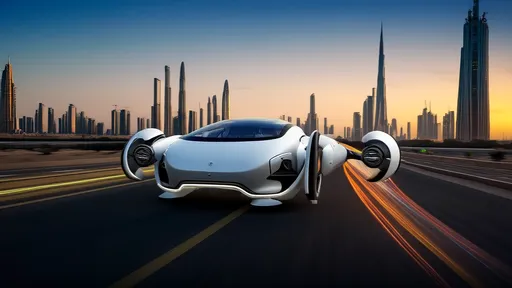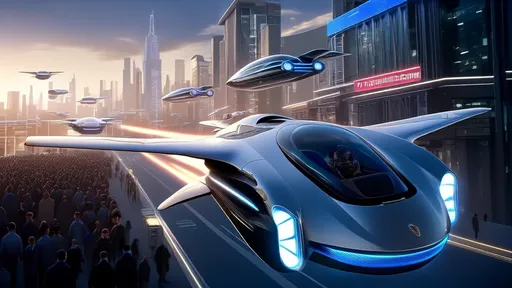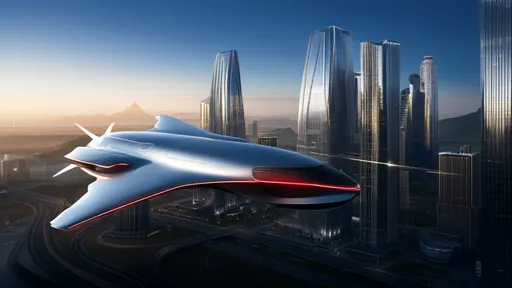In a landmark recognition of human engineering prowess, China's full-ocean-depth manned submersible has been selected among the 2025 Top Ten Global Engineering Achievements, standing shoulder-to-shoulder with revolutionary projects like quantum computing infrastructure and Mars colonization prototypes. This prestigious listing, announced by the International Engineering Consortium earlier this morning, represents more than just technological acknowledgment—it signifies humanity's renewed commitment to conquering Earth's final frontier.
The selection committee's chairperson, Dr. Elena Vorster, emphasized during the Geneva announcement that "this particular achievement represents something fundamentally different from our other honorees. While we celebrate innovations that look outward to space or inward to quantum scales, the full-ocean-depth submersible reminds us that profound mysteries remain right here on our home planet, waiting in the crushing darkness of the hadal zone." Her words echoed through the packed auditorium, where engineers from seventeen nations had gathered for what many are calling the "Olympics of technological achievement."
What makes this recognition particularly significant is the timing. Just three years ago, China's deep-sea exploration program was considered ambitious but still developing compared to established programs in the United States and Japan. The rapid advancement to full-ocean-depth capability—capable of reaching the very bottom of the Mariana Trench at nearly 11,000 meters—has stunned the marine engineering community. Industry analysts note that the compression of this development timeline represents one of the most accelerated technological maturation processes in modern engineering history.
The submersible itself, named "Striver" in English translations, represents a symphony of engineering innovations. Its personnel sphere, crafted from a novel titanium alloy, can withstand pressures exceeding 1,100 atmospheres—equivalent to balancing the entire weight of the Eiffel Tower on a single dinner plate. The development team overcame what engineers called "the transparency paradox"—the need for viewports that provide visibility while resisting unimaginable compressive forces. Their solution involved a fused silica composite that maintains optical clarity while offering strength characteristics previously thought impossible for transparent materials.
Perhaps the most groundbreaking aspect of Striver's design lies in its power systems. Unlike previous deep-sea vehicles that relied on limited battery capacity, this submersible employs a hybrid power system combining advanced lithium batteries with hydrogen fuel cells, enabling mission durations of up to fourteen hours at maximum depth. This endurance represents a quantum leap in deep-sea exploration capability, allowing scientists to conduct complex research programs rather than brief reconnaissance missions.
The selection committee highlighted the submersible's scientific payload as particularly impressive. "We're not just looking at a vehicle that can reach the bottom," noted marine biologist Dr. Kenji Tanaka, who served on the evaluation panel. "We're looking at a mobile laboratory equipped with DNA sequencers, chemical sensors capable of detecting single molecules, and manipulator arms with surgical precision. This transforms the vehicle from an observation platform to a discovery engine."
International collaboration played a crucial role in the submersible's development, despite its national designation. German engineering firms contributed to the pressure compensation systems, Canadian companies developed the advanced sonar mapping arrays, and Norwegian researchers co-designed the biological sampling apparatus. This global knowledge exchange exemplifies how modern engineering achievements increasingly transcend national boundaries while still showcasing individual nations' capabilities.
The practical implications of this technological milestone extend far beyond scientific curiosity. Deep-sea exploration directly contributes to our understanding of climate change through study of deep ocean currents and carbon sequestration processes. Medical researchers are particularly excited about the potential for discovering novel compounds from deep-sea organisms that have evolved unique biochemical strategies to survive extreme conditions. Early sampling missions have already identified several microorganisms with enzyme systems that function under conditions previously considered incompatible with biological activity.
Resource exploration represents another significant application. The submersible's ability to directly observe and sample polymetallic nodules and hydrothermal vent systems provides crucial data for responsible resource management. As terrestrial mineral deposits become increasingly scarce, the ethical development of deep-sea resources may become essential for continuing technological advancement across multiple sectors.
Safety systems aboard the vessel represent another area of engineering innovation. The submersible features redundant life support systems, emergency ascent mechanisms, and a unique "safe haven" compartment designed to sustain crew for up to 96 hours in case of entrapment or system failure. These safety innovations have already influenced design standards for commercial and research submersibles worldwide, potentially saving lives across the entire deep-sea exploration industry.
The human factor in this achievement cannot be overstated. Piloting a vehicle to such depths requires extraordinary skill and courage. Test pilot Commander Li Wei, when asked about the psychological challenges of descending into complete darkness with the knowledge that any failure would be catastrophic, remarked that "we don't focus on the pressure outside the hull, but on the purpose inside it. Every meter descended represents another meter of human understanding gained." This philosophical approach to extreme engineering has resonated throughout the global technical community.
Looking forward, the technologies developed for the full-ocean-depth submersible are already spawning innovation in other fields. The advanced composite materials are being adapted for space vehicle construction, the pressure-resistant electronics have applications in deep-Earth drilling, and the navigation systems are influencing autonomous vehicle development. This technological diffusion exemplifies how focused engineering achievements can catalyze advancement across seemingly unrelated domains.
The selection of China's submersible among the world's top engineering achievements comes at a pivotal moment in deep-ocean exploration. With multiple nations racing to develop capabilities for the hadal zone, this recognition validates an approach that balances technological ambition with scientific purpose. As the international community begins to establish frameworks for deep-sea resource management and environmental protection, the Striver submersible provides both a tool and a symbol—demonstrating that human ingenuity can extend our presence to the most inhospitable environments while maintaining respect for their pristine nature.
In the broader context of the 2025 Top Ten Global Engineering Achievements, the full-ocean-depth submersible stands as a testament to humanity's enduring drive to explore, understand, and gently inhabit every corner of our world. While other honored projects look to the stars or manipulate the fabric of reality at quantum scales, this achievement reminds us that profound discoveries await in the mysterious depths of our own planet's oceans. The selection committee's recognition ensures that deep-sea exploration will receive increased attention and resources, potentially accelerating our understanding of Earth's final frontier within our lifetimes.
The once-fantastical vision of humanoid robots, long confined to the pages of science fiction and the silver screen, is steadily materializing into a tangible engineering reality. This evolution is not the result of a single, monumental breakthrough but rather a profound and intricate symphony of advancements across a multitude of scientific and engineering disciplines. The quest to create machines that not only look but also move, perceive, and interact with the fluidity and adaptability of humans represents one of the most ambitious technological endeavors of our time. It is a grand convergence, where progress in artificial intelligence, materials science, mechanical engineering, and cognitive science coalesces to breathe life into metal and silicon, pushing the boundaries of biomimicry to unprecedented heights.
The recent inclusion of humanoid robots in the 2025 Top Ten Global Engineering Achievements marks a watershed moment in technological history. This recognition transcends mere academic acknowledgment; it represents a collective global validation of decades of research, development, and iterative innovation in robotics. For years, humanoid robots existed primarily in the realms of science fiction and laboratory prototypes, often viewed as fascinating but distant curiosities. Their elevation to a top global engineering feat signals a profound shift—a transition from conceptual marvels to tangible agents of change poised to reshape our societal and industrial landscapes.
In a landmark recognition of human engineering prowess, China's full-ocean-depth manned submersible has been selected among the 2025 Top Ten Global Engineering Achievements, standing shoulder-to-shoulder with revolutionary projects like quantum computing infrastructure and Mars colonization prototypes. This prestigious listing, announced by the International Engineering Consortium earlier this morning, represents more than just technological acknowledgment—it signifies humanity's renewed commitment to conquering Earth's final frontier.
In the heart of Dubai's morning rush hour, the familiar gridlock of Sheikh Zayed Road stretches for kilometers below, but above the shimmering asphalt, a new dimension of transportation is quietly rewriting the rules of urban mobility. As first reported by The Times of India, the city's ambitious flying car initiative has transitioned from futuristic concept to operational reality, with commuters now gliding between skyscrapers in electric vertical take-off and landing vehicles. This isn't a scene from a science fiction film but the new daily reality for a growing number of Dubai residents who have traded their terrestrial commutes for the freedom of three-dimensional travel.
The desert skies of the United Arab Emirates, long dominated by the sleek silhouettes of commercial airliners and private jets, are poised to welcome a new kind of vessel. In a landmark decision that signals a significant leap from science fiction to tangible reality, a specific model of flying car has been granted a special certificate of flight from the UAE's civil aviation authority. This is not merely a provisional test permit for a closed course; it is a crucial regulatory nod that brings the vision of urban air mobility one giant step closer to the daily lives of the region's residents.
In a move signaling a new era of technological collaboration, Southeast Asian nations and the United States are forging a groundbreaking partnership in artificial intelligence development. This strategic alliance emerges at a critical juncture when global AI governance remains fragmented and the technology's potential to reshape economies and societies becomes increasingly apparent. The collaboration represents more than just technical cooperation—it embodies a shared vision for responsible innovation that respects cultural diversity while addressing common challenges.
The Euclid Space Telescope, humanity's newest and most ambitious eye on the cosmos, has begun its monumental mission to pierce the profound darkness that envelops our universe. Launched into the silence beyond our atmosphere, its purpose is not merely to capture stunning celestial portraits but to map the invisible architecture of reality itself. For decades, astronomers have known that the cosmos we see—the glittering tapestry of stars, galaxies, and nebulae—comprises a mere five percent of the total content of the universe. The remaining ninety-five percent is a profound mystery, a dual enigma composed of dark matter and dark energy. These are the phantoms of physics, entities that do not emit, absorb, or reflect light, yet whose gravitational influence dictates the fate of everything we hold visible. Euclid is our most sophisticated attempt to date to bring these shadows into the light, to understand the hidden forces that have shaped the universe's past and will determine its ultimate destiny.
Beijing's National Stadium, once the iconic centerpiece of the 2008 Summer Olympics, echoed with a different kind of applause this week. The thunderous cheers were not for human athletes pushing the limits of physical endurance, but for their mechanical counterparts—humanoid robots competing in the inaugural World Humanoid Robot Sports Games. The air, thick with the whirring of servos and the collective anticipation of engineers and spectators, marked a pivotal moment in the history of robotics and international sport.
The landscape of oncology treatment is undergoing a profound transformation, driven by the emergence of third-generation antibody-drug conjugates (ADCs). These sophisticated therapeutic agents represent a significant leap forward in the quest for precision medicine, offering new hope for patients battling various forms of cancer. Unlike conventional chemotherapy that attacks both healthy and cancerous cells indiscriminately, these advanced biologics deliver potent cytotoxic agents directly to tumor cells, minimizing damage to healthy tissues and reducing debilitating side effects.
In the relentless battle against cancer, a revolutionary class of therapeutics has emerged, earning the evocative moniker of "precision missiles" for their ability to deliver potent cytotoxic agents directly to malignant cells while sparing healthy tissue. These are Antibody-Drug Conjugates, or ADCs, and they represent a sophisticated fusion of biologic targeting and potent chemotherapy, a paradigm shift in oncology that is redefining treatment expectations for a growing number of cancers.
The desert skies above Dubai witnessed a historic moment last week as the sleek silhouette of a flying car cut through the cerulean blue, marking what many industry experts are calling the dawn of a new era in personal transportation. The demonstration, orchestrated by the pioneering aviation firm AeroMobil Emirates, was not merely a test flight; it was a powerful statement of intent, a tangible promise of a future once confined to the pages of science fiction.
In a remarkable demonstration of growing consumer confidence in aerial mobility solutions, global pre-orders for flying cars have surged past the 7,000-unit milestone. This significant threshold, reached far earlier than most industry analysts had projected, signals a fundamental shift in public perception about the viability of personal air transportation. What was once confined to science fiction novels and futuristic concept videos is rapidly transforming into a tangible consumer product category with demonstrated market demand.
In the shimmering heat of the Arabian Gulf, a new silhouette is beginning to pierce the horizon. It is not the familiar form of a commercial airliner nor the sleek profile of a private jet, but something altogether more futuristic—a flying car. This vision, once confined to the realms of science fiction, is fast becoming a tangible reality, and it is Chinese innovation that is poised to turn the skies above Dubai, Abu Dhabi, and Riyadh into a dazzling new theater of urban mobility.
The relentless march of artificial intelligence demands computational power on a scale previously unimaginable. At the heart of this revolution lies the Graphics Processing Unit, or GPU, which has evolved from a specialized graphics rendering component into the primary engine for AI workloads. The latest generation of GPU architectures represents a paradigm shift, not merely an incremental improvement. These new designs are fundamentally re-engineering the silicon to tackle the unique and colossal demands of modern AI, with a core focus on achieving unprecedented levels of computational density and efficiency through hyper-scale integration.
The ASEAN-US AI Cooperation Forum concluded its third annual session this week with a renewed commitment to bridging the digital divide through focused capacity building and infrastructure development. Held against the backdrop of rapid technological advancement, the forum brought together policymakers, industry leaders, and academics to chart a collaborative path forward, recognizing that the benefits of artificial intelligence must be distributed equitably to ensure regional stability and prosperity.

